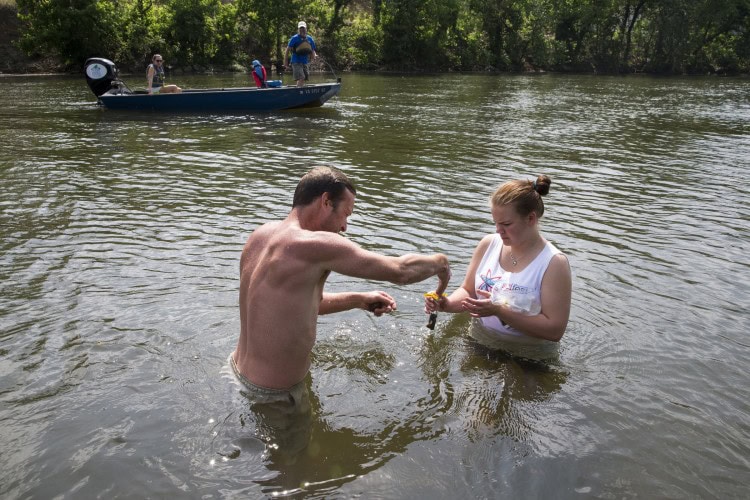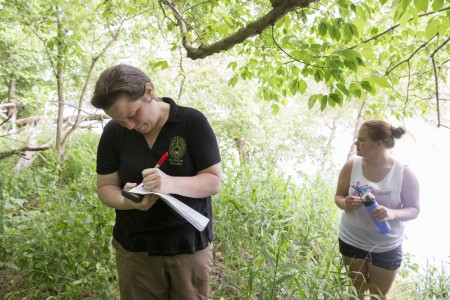Students get a ‘sample’ of environmental pollution testing during Summer Research

Allison Brooks ’18 and Rob Campbell ’13 collect soil samples by hand while Melissa Pasierb ‘17 and River Keeper Pat Calvert test other sites from a motorboat.
Dams have long been recognized as key contributors to producing clean energy through hydroelectric power, but one that is causing environmental concerns in Lynchburg is giving a group of Randolph researchers the chance to put their scientific skills into action—and help the community at the same time.
Environmental science majors Allison Brooks ’18 and Melissa Pasierb ’17 are working with physics and environmental studies professor Sarah Sojka to examine the feasibility of removing the RockTenn Dam, which is located near downtown Lynchburg. Earlier in the summer, they collected silt, sand, and rock sediment samples from the James River near the dam. They are now testing those samples back in the lab to determine grain size percentages and to look for any trace of harmful substances like lead, mercury, cadmium, or iron.
Last week, they placed the samples in acid to force out any metal concentrations. After this process, they will run them through a flame atomic absorption spectrometer. The device, Sojka said, combines two things chemists enjoy most–-acid and fire–-to determine what is in each sample.
The students are examining samples taken both near the dam as well as from three other areas in the river to determine if the dam has contributed to the pollution. Two of them are sites where oil spilled from a derailed train last year, and the other is Percival’s Island, where Sojka said pollution has caused severe erosion.
“At the beginning we thought there was going to be a lot of trapping behind the dam, but now we’re figuring out that a lot of the sediment’s washed out, so that’s going to affect the results we get in other areas,” said Pasierb.
“I think we would be really surprised if there wasn’t lead in the sediments in this area, given the history of a lot of lead based paint, fuels and all those things,” said Sojka. “What we’re trying to notice is if it’s worse behind the dam.”

Environmental science professor Sarah Sojka records one of the testing sites near Percival’s Island.
Sojka hopes her students’ work will reveal any environmental problems the dam is causing, and also provide information about potential public safety hazards, since it is poorly marked for canoers and hikers.
“This is a pretty tightly defined eight-week project, but so many things could come from it,” she said.
Brooks and Pasierb have enjoyed working with the James River Association and a Randolph alumnus who works there, Rob Campbell ’13. The project has allowed the students to learn more about the James River while gaining experience in the scientific process.
“They’re really knowledgeable of the history of the area and the problems with the James River,” Pasierb said about the James River Association and its volunteers.
The Summer Research project has given Brooks ideas about a potential career.
“I always knew I would be in environmental science, I just never knew what the other aspect would be,” she said. “I love the science of it, but I also really like the education and outreach side of it too.”
Tags: Allison Brooks, environmental science, Melissa Pasierb, Sarah Sojka, summer research, Summer research 2015
